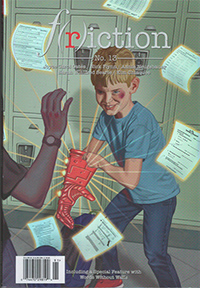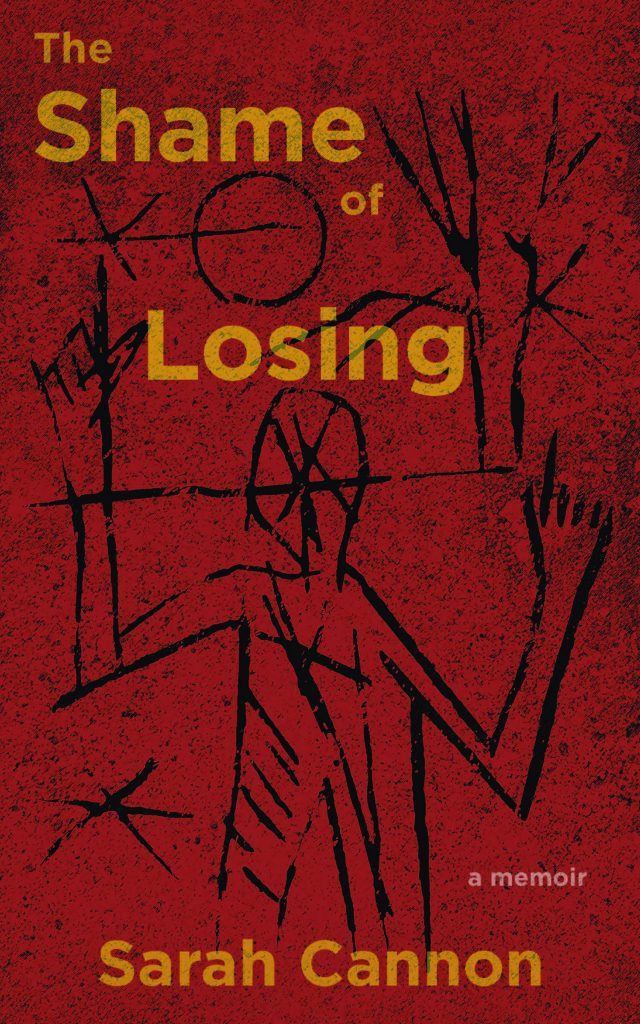F(r)iction is the emboss of the international literacy nonprofit Brink Literacy Project. With a mission to escalate literacy rates and a commitment to storytelling, the magazine is by no means conservative. This literary journal is eye-catching, from its holographic cover, to its full-color pages. Each page is a visual delight and tactile treat, featuring original short comics. The artwork is well-defined and accompanies every piece. It represents young, underrepresented and diverse writers. In its wide array of genre and artwork, there are no borders, which makes the collection as a whole, highly baffling in its surprises, all for the sake of creative writing and fine art. F(r)iction takes risks with form and content in a mixed bag of goods, reveling in the unexpected, and rewarding inventiveness and insight in works from traditional literary fiction or genre-bending sci-fi, fantasy, horror poetry, and nonfiction¾all accessible to the reader.
It features edgy, gut-wrenching, and raw poetry by Nick Flynn and Alli Cruz; animalistic, wild, and weird short fiction from Annie Neugebauer, Jason Baltazar, Samantha Schmidt, Jason McCormick, Alexandra O’Neil, and Vaughn Gaston. You’ll find pleasant revelations of creative nonfiction by Patricia Horvath, a pioneering writer feature with Joyce Carol Oates, a breaking ground debut author feature with Emily A. Duncan, and a community feature with Words Without Walls Prison Writing Program. In partnership with Words Without Walls, F(r)iction stays true to their mission, giving back to the community, and with that trade-off, we get a glimpse inside the minds of writers in Allegheny County Jail and Sojourner House with important words to be shared in multiple pieces in which we would know about otherwise. In a world that puts trust in the established, F(r)iction dares to challenge this notion, welcoming new writers to emerge with celebrity writers.
Writing world: take note. Readers: hold onto your seat. F(r)iction is fresh, providing menace to the publishing world in its beyond imaginative and interesting curated work.
Review by Lejla Subašić
F(r)iction, a print journal dedicated to publishing eclectic works, began in 2015, with an aim to do things differently. A letter from the editor on the first page of the journal is a call to action that in so many words encourages the reader to not let good, weird literature die. Those experimental pieces writers keep tucked away in lonely computer files and desk drawers have a home in F(r)iction.
F(r)iction announces itself as a different-kind-of-journal from the cover. Issue No. 13 beams an iridescent image of a devious child with a mechanical glove and homework glowing and floating around him. Embedded in this image is Joyce Carol Oates’ name among others, a nod to the magazine’s clout, enough to garner big literary names while still publishing new, emerging writers. With glossy, bright pages decorated with varied art submissions, it’s a journal that could cause a riot at the book fair while it leaves adults daydreaming, connected with their inner child.
I thought, based on the cover and colorful pages, F(r)iction would be lighthearted and playful. It is, in some respects. However, shortly after diving into a story adorned with illustrated peanut butter and jelly sandwiches, I was dumbstruck and heavy. “How to Make a Peanut Butter and Jelly Sandwich” by Samantha Schmidt tells the story of a cook for prisoners’ last meals and one odd request for a PB&J. The cook grapples with how to make something ordinary extraordinary and momentous. The story draws irony from the most conventional tradition in our society of making death (a common, ordinary thing) into a grand, special event. After reading this story, I am left in my reading chair, holding my head wondering how I let a literary magazine—one that told me it would be strange and thought-provoking—convince me it would be all play.
This is perhaps exactly what F(r)iction is aiming for. The name speaks to its efforts; it goes against the grain and causes a reaction. In addition to their print issues, F(r)iction’s website is just as glossy. Its navigable format displays a log of numerous categories, a testament to its variety. They feature comics, creative nonfiction, editorial, essays, interviews, flash fiction, poetry, read-alongs, reviews, short stories, and staff picks.
Where F(r)iction’s letter from the editor might tell a story of the underdog, a magazine fighting to stay afloat, the pages tell a different story. Each page radiates vivacity and radical confidence in the power of art. F(r)iction is armed with a glimmering mechanical glove and ready to fight.
Review by Brigitte Riordan
In many ways, a magazine—digital or hardcopy—constantly requires a fresh and bold adaptivity to the changing world around it. This lays heavily upon literary journals; the stories and narratives they contain represent the undertones of today’s society that are embedded in worlds either fictional, or not. In F(r)iction, the eyes are drawn in by the vivid color, images, and layout of the magazine. The most provocative section was created with the special feature “Words Without Walls,” a creative outreach program serving Allegheny County Jail, and Sojourner House, a residential drug and alcohol treatment program for mothers and their children. The visual artists for this magazine take big steps into making F(r)iction appealing to the eye, but what of its content?
The mission of this magazine is clear within the Editor’s Note, “. . . a collection of stories that would enchant us regardless of genre, where the biggest names in the industry shared a spine with brand new voices from diverse backgrounds. . . . It would be a book brimming with color and art and specialty printing.”
In other words, the magazine includes a variety of poems, short stories, interviews, and comics that all act to dismiss the quota of “traditional literature,” and although “Words Without Walls” is the special feature, the entire magazine plays off as such. Every story conspires with an image, playing off of the details within the stories. Each snippet of these give you a variety of narratives, sprouting from “Freaks” within a cruel circus, to warrior women whose bloodline are destined to kill off the beasts of their world.
The magazine does not disappoint with its inclusion of the witty, bizarre, and unique.
Review by Tracie Taylor
F(r)iction is a magazine that sees no limits and knows no boundaries, where both established and new writers have an equal opportunity to share their work. The magazine is one of the liveliest that I’ve seen, with a vibrancy that clearly encapsulates the passion of the writers and artists featured within its pages.
The relationship between story and illustration can be a challenge to navigate. It’s difficult to have those two elements coexist without one overshadowing the other, but F(r)iction found the perfect balance. The artwork not only compliments the stories, but propels them, and helps the reader become fully immersed in the writing.
“Clean Slate,” written by Jason McCormick with artwork by Enrica Angiolini, was one of the first stories that really stuck out to me. It was the bright neon graphics that caught my attention, and the first sentence, “I have purchased 28 boxes of chalk over the semester, and that is simply too much” drew me completely in. “Clean Slate” followed the story of a professor whose chalk kept going missing.
The professor waited for hours in the classroom to catch the culprit, but ended up falling asleep, and woke up at midnight to find that the new chalk that was left out had gone missing yet again. The professor rushed out of the classroom and saw a janitor pushing a cart down the hallway, and followed the janitor to the elevator and up to the roof. After stepping out onto the roof, the reason why the chalk had been going missing became apparent; the ground was covered in drawings of stars and planets, and in the midst of that, a game of hopscotch.
The illustrations that were paired with this story did the job of providing the reader with a clear image of what the narrator was seeing. A mental image could have been formed without the use of artwork, sure, but then the story wouldn’t have been the same. A drawing of the hopscotch game took up the center margin, and the outside border was filled with neon red and blue and pink graphics of flowers and stars, and the black background the words and artwork were set on, made the graphics stand out even more.
The primary goal in Issue 13 of F(r)iction was to drift away from the traditional and take risks. Dani Hedlund, editor-in-chief of F(r)iction, states, “We dreamed of something different¾a collection of stories that would enchant us regardless of genre, where the biggest names in the industry shared a spine with brand new voices from diverse backgrounds, voices we would mentor every step of the way.”
Review by Katie Turner
At first glance, “the comeback issue” of F(r)iction, published in the spring of 2019, is for Mad Libs lovers, a mischievous little boy on the cover, ready to take Thanos-style revenge on his schoolyard bullies. I entered my reading experience thinking this was a magazine geared toward youngsters like the boy on the cover, and was quickly disabused of that notion with the first story’s writhing grotesque of a main character, Centavo, also known as the shapeshifting Amorpho of the Cosmideluxe Circus and Sideshow.
Jason Baltazar’s imagery is precise within the story, describing how it feels to rearrange the muscles, arteries, and bones in time with music; how it feels to float formless on a peaceful pond; and how it feels to pander to a nameless crowd with your true self exposed many times over.
But before we even get to the opening story, “Amorpho and the Leering Freak,” we read the Editor’s Note, adoringly addressed to “Dear lovely reader.” Within, Editor-in-Chief Dani Hedlund promises “a collection of stories that would enchant us regardless of genre, where the biggest names in the industry shared a spine with brand new voices from diverse backgrounds. . . . It would be a book brimming with color and art and specialty printing. Every page would be as lush as the stories within.” Hedlund and her crew deliver.
For each page—even the table of contents—is jam-packed with specially-created art (even to the detriment of not having a page number most times). For every poem, the title is blended seamlessly into the art. Snippets of the art is featured in the handful of stories featured online from each printing, but the true decadence lies in holding the physical copy in hand. The cover shines with luminescent flashes of reflective sparkles. The deep reds and vibrant greens drip off the page¾the page itself transformed into the precise artwork needed to enhance and accompany each story, interview, or poem.
While “Amorpho and the Leering Freak” is sympathetic horror, “The Reds,” by Annie Neugebauer, is the classic Little Red Riding Hood fairytale expanded—the lineage of grief and revenge left behind after little red riding hood has been digested by the big bad wolf.
Side by side with these two genre-bending stories are the real truths told by female inmates via the Words Without Walls Prison Writing Program and an interview with prolific author Joyce Carol Oates.
The F(r)iction crew’s love for this “weird little book” is palpable and brave. F(r)iction was “fueled by passion and naivety and stubbornness” when they started their strange and artful literary journal, and they still are. In Hedlund’s note she promises the magazine will expand, to find new ways to thrive because the crew “love[s] stories. We believe in their power to change the world.”
Check them out at frictionlit.org to see what they have to offer. You will be pleasantly surprised at what a literary journal can say and do with just a little bit of passion, naivety, and stubbornness.
Review by Rachel Martin
The cover of the Spring 2019 issue of F(r)iction magazine is iridescent and glossy. There is a young boy illustrated with a mischievous expression, a bruise on his cheek, and wearing a mechanical red glove. There are beams of energy expanding out from the mechanical hand. There are school lockers behind him and papers that look like worksheets from class suspended in air and outlined in iridescence. In the editor’s note, I am greeted by the Editor-in-Chief, Dani Hedlund, addressing me as “lovely reader.” They are informing me of the struggle that the literary journal industry entails: dwindling readership, mentorship not being economically viable, and the foolishness of creating an issue with emerging artists—yet they notified me of their expansion as a magazine.
I find that the cover and the editor’s letter are very intuitive. They seem to embrace the “weirdness” of our world, leading the reader to “reimagine the way you see the world.”
F(r)iction magazine is full of underdog stories and they are each “steeped in fighting spirit.” This is evidenced by Nick Flynn, whose work is presented on pages 18 through 21. His three poems involve famous musicians. The first poem is titled, “Alphabet Street” and it describes a moment between the speaker and their daughter, listening to the radio. The daughter asks why the radio is talking about a person who has just died. “Why is anyone so / important?” The poem ends by including the lyrics of Alphabet Street by Prince in italics, “No / one, nothing—if that’s / the only way—is / replaceable.” The next poem, titled, “Rock ‘N’ Roll Suicide” is about the speaker’s daughter drawing a picture and in the last lines, David Bowie’s lyrics are intertwined in the moment with promises of not being alone. The last poem by Nick Flynn is titled, “Kurt Cobain Wallpaper.” The three poems not only include classic artists, but also personal thoughts and experiences by the speaker. He gives a feeling of staying alive through mundane moments, appreciating the present, and using music as a way to bridge the gap between experience and thought.
Although F(r)iction has well known writers, such as Joyce Carol Oats whose writing took the center of the magazine, the underdog theme is carried through. The fact that they feature writers from Words Without Walls—an outreach program that serves women in jail and women in a residential drug and alcohol treatment program, I hope to see more boundaries broken by this magazine in the future. Their expansive energy is enough to keep them moving forward.
Review by Riley McFarlane
In an industry where they “see great journals go under,” F(r)iction made it a mission to maintain their momentum and put together a selection of work of varying genres and forms by writers in different stages of their careers. Literary fiction and dark fantasy, short poetry and comics—this volume has variety. All of it is accentuated by eye-catching and, at times, bombastic artwork, tailor-made to each of its featured stories.
Each individual piece is united by the theme of underdogs. They take stories of characters in an oppressing, hostile environment seemingly out to beat them down, and how they lead their lives. And each author manages to use this theme in unique ways.
Annie Neugebauer’s “The Reds” tells a chillingly dark story of girl born into her role as a “Red”, forever bound to her duty of hunting beasts by a legacy of women before her. The bloody, graphic imagery contrasted with the protagonist’s cool and at times beaten voice captures the imagination. Vaughn Gaston’s “Snargle Fox” experiments masterfully with point of view, head hopping from one character to another, never content to remain in the same place for more than a few paragraphs at a time, ending with a surprisingly beautiful narrative.
As for poetry, I’d like to direct the reader’s attention to “A Dog Ran Down the Highway” by Kim Chinquee. For a poem less than fifteen lines, Chinquee’s work tells a far too familiar story of a woman’s relationship through implication alone. The last line, “Oh, no. I said. You’re not.” ends the poem on a note that, while not a conclusion to the woman’s story, is a gut-punch that I think everyone needs to read in context.
The work discussed above barely scratches the surface of F(r)iction‘s spring 2019 issue has to offer. The comics are beautiful, the poems, concise, the non-fiction, revealing. But, there’s something more magical about F(r)iction magazine’s spring volume that goes beyond the stories that it includes—something that may well apply to F(r)iction as a whole. It’s devotion to making each of its contributing author’s stories the star of its own show, is truly what makes F(r)iction a joy to read. I’ve read many anthologies that include sparse amounts of artwork, aside from the obligatory cover photo, that will draw in a reader browsing a rack of magazines. F(r)iction on the other hand has incredibly detailed artwork for every one of its stories, accompanied by pages accented by border, page breaks, and art in the margins that fit its aesthetic. If there is anything to take away from F(r)iction’s spring 2019 volume, it’s that they will spare no expense in making sure everything they publish is as polished and detailed as humanly possible. Some of the stories mentioned in this review are available on their website, and I highly recommend that you check them out.
Review by Elijah Abarbanel



